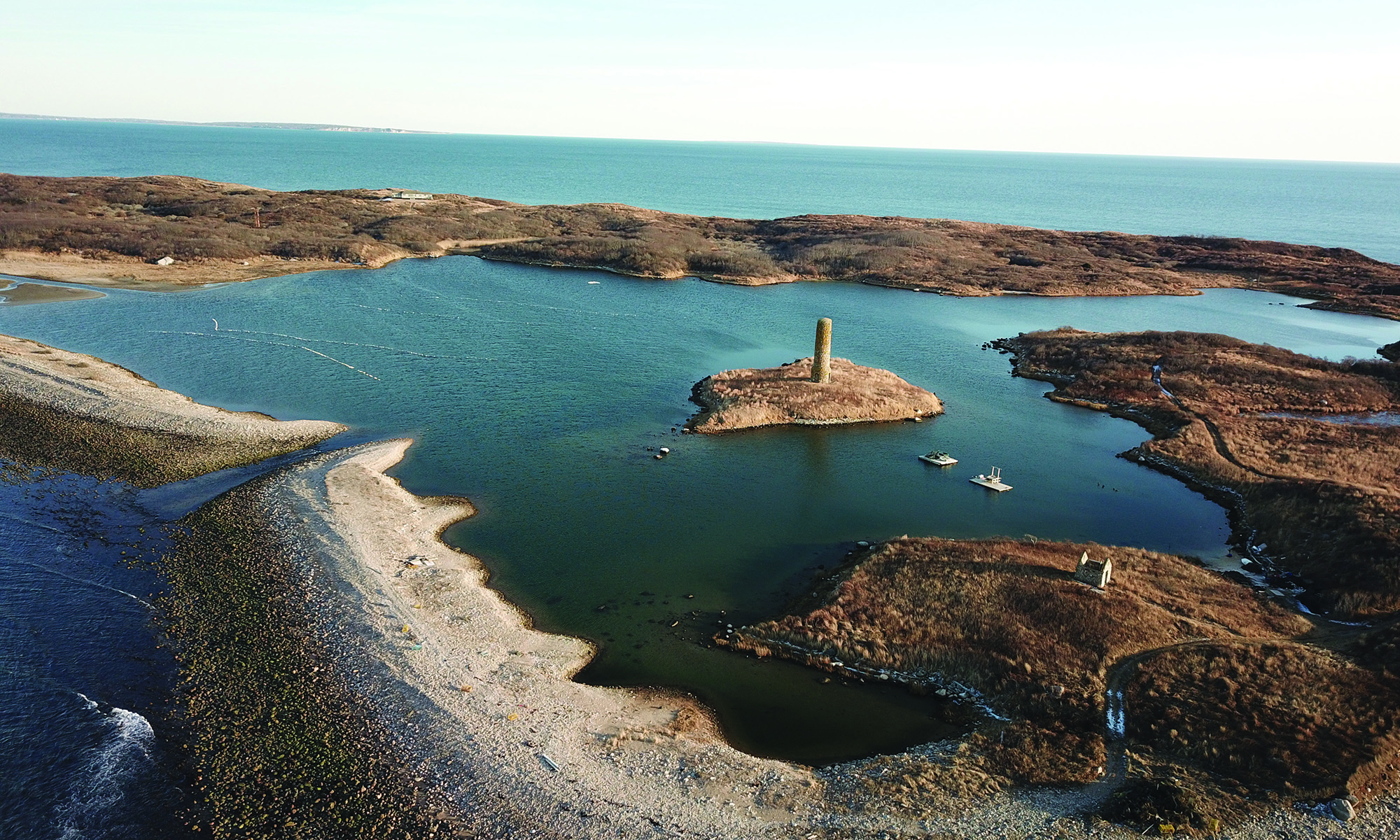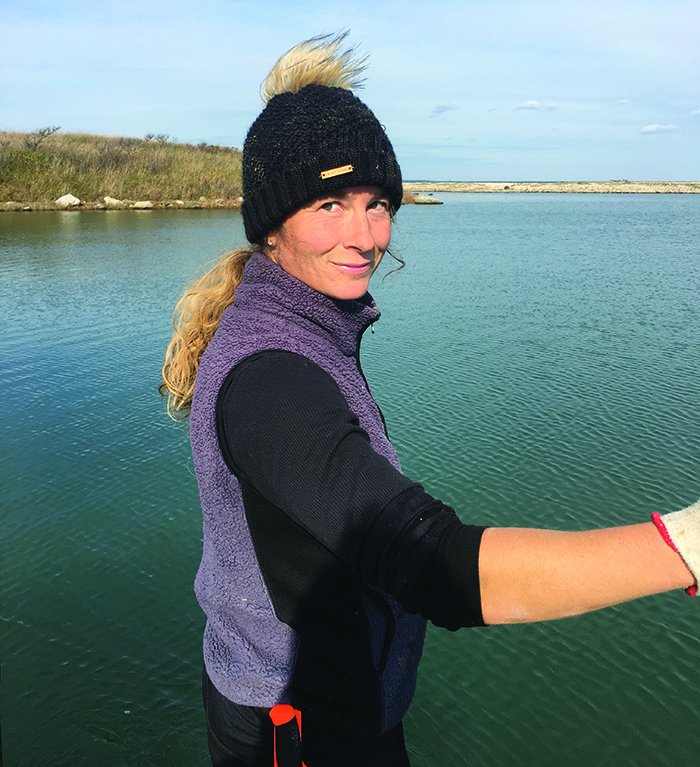
Southwest of Cape Cod, Cuttyhunk Shellfish Farms, led by Charmaine Gahan, AB’00, produces oysters with a singular “merroir”—a flavor profile shaped by the unique combination of environmental elements at work on Cuttyhunk Island. (Photo courtesy Charmaine Gahan, AB’00)
Charmaine Gahan, AB’00, is fulfilling a teenage dream as the owner of Cuttyhunk Shellfish Farms.
As a high schooler, Charmaine Gahan, AB’00, found her calling on an oyster farm at the farthest edge of a tiny island chain off the coast of Massachusetts. Then, 30 years later, she found her way back to it.
“OK, here we are,” she says, switching off the ignition of her olive-green four-wheeler and looking out across a sprawling salt pond, where 300,000 oysters are growing underwater in nets suspended from long lines of white buoys. Soon the tide will wash back in, bringing fresh nutrients and plankton to feed the oysters. This is the operations hub of Cuttyhunk Shellfish Farms, on Cuttyhunk Island.
Two years ago, following a career in business that felt more like a detour, Gahan purchased the farm from her former boss Seth Garfield, who had started it with his wife in 1981. Over the decades, Garfield has employed hundreds of young people to help bring in the oyster harvest—the children of Cuttyhunk residents and regular vacationers, or those with some other connection to the island. “Probably 80 percent of the kids on the island over the generations have worked with us at some point,” he says. When she was 17, Gahan became one of them.
She spent several summers hauling nets and shucking oysters before returning home to the mainland every fall for school in Concord, Massachusetts. The experience was formative. In her UChicago admissions essay, she described a day spent working with Garfield: piloting his boat through the early morning fog, picking exotic sea creatures out of the shimmering slime caked onto the oyster traps. Her grandfather had been a commercial fisherman, and the work felt right. “My favorite thing was to be out here on the water,” she says. “That’s what I really wanted.”
She also felt drawn to the island itself. Cuttyhunk, a remote squib of sand, scrub trees, and white clapboard cottages, is situated on the outermost edge of the Elizabeth Islands chain southwest of Cape Cod. It and the other islands comprise Gosnold, the tiniest town in Massachusetts—around 70 residents, according to the US Census. In summer the population swells to 400 or more (besides vacationers, the island is a magnet for striped bass fishermen), but fewer than a dozen hardy locals stay on through winter.

Last December, Gahan says, there were three other people there besides her. Wi-Fi is spotty, there’s no doctor’s office, and class sizes in the one-room schoolhouse can be in the single digits. Full-time residents like Garfield fill multiple roles: among his many responsibilities, he’s the fire chief and the emergency response manager, he serves on the town’s finance committee, and he assists with solid waste management. Though he retired from teaching science at the school, he substitute teaches when called on; he also runs his own landscaping business on the side. The same is true now of Gahan, who is in and out during the winter and on the island full time the rest of the year. “I have jumped in to clean the public toilets, collect trash, dig a grave, clear a road, help change the oil on a diesel generator at the powerhouse,” she says.
After college, where Gahan majored in history and played on the women’s soccer team, she felt pressure to get a “serious” job. And so she did, working in finance and health care industry positions that took her to Philadelphia, California, and South Korea. She got married and had children (Nathalie, 18, and Lola, 16), and eventually the family moved back to Massachusetts. She visited Cuttyhunk every summer, and the farm remained on her mind—a “maybe someday,” an unfulfilled idea.
Then the pandemic hit and the world abruptly halted. Gahan wondered if, in that sudden shift, there might be an opportunity. Garfield was nearly ready for retirement and encouraging her to buy him out. That winter she moved to Cuttyhunk full time to try out the idea, helping him manage the farm and teaching gym and social studies at the school. She and her husband decided it could work, and she made the leap. “This is my second chance,” she says.
On this morning, a sunny Friday in late July—the height of oyster season—her own crew of young farmhands (including her daughters) have been at work in the salt pond for hours, hoisting heavy lantern nets out of the water and onto a homemade wooden raft, sorting the harvest-ready oysters from the “carry-backs” that aren’t yet big enough. The ideal size, Gahan says, is 2.5 to three inches long, with a “nice deep cup” in the bottom shell—plenty of room for meat. “You learn to eyeball it,” says UChicago student Sam Heintz, who spent several summers on the farm, starting at the age of 13. “After you’ve been on the farm for years, shucking oysters, you kind of know what the oysters are going to look like [inside].”
And what they taste like? “Briny and sweet,” says Garfield (who’s staying on temporarily as an “operations guy” and on-call expert while Gahan learns the ropes). “Fresh and crisp,” offers Heintz. “I mean, these oysters are literally commuting less than a mile and a half to where they’re being served. They’re coming straight out of the ocean.”
He’s talking about the farm’s raw bar. While Gahan delivers oysters year-round to restaurants on the mainland—an hour-long boat ride across Buzzards Bay—and caters parties and events on the island, from late spring through early fall she and her staff also serve shucked-on-demand oysters and other seafood out of a shack at the harbor. And customers can flag down Gahan’s “floating raw bar,” operated from a skiff that circulates the marina every evening, from their yachts and sailboats.
When you ask Gahan about the taste, she mentions what’s sometimes called “merroir,” the sea-soil version of vineyards’ terroir. “Oysters have a flavor profile specific to where they were grown,” she says. On Cuttyhunk, 16 miles off the coast, that flavor profile flows in from the open ocean. Studies have suggested a number of environmental benefits to oyster aquaculture: there’s no fertilizer or feed, and there’s very little mechanized equipment—plus, oysters eat algae and filter particulates out of the water while their nets give shelter to other marine animals. To Gahan, all of that is part of the taste, along with the salt and the sediment and the washing tides. And so too is the community where Cuttyhunk Shellfish Farms is rooted, small and self-reliant. Growing oysters here is an experience as deep and layered as the shells she and her crew draw up from the water, summer after summer after summer.
